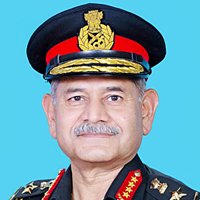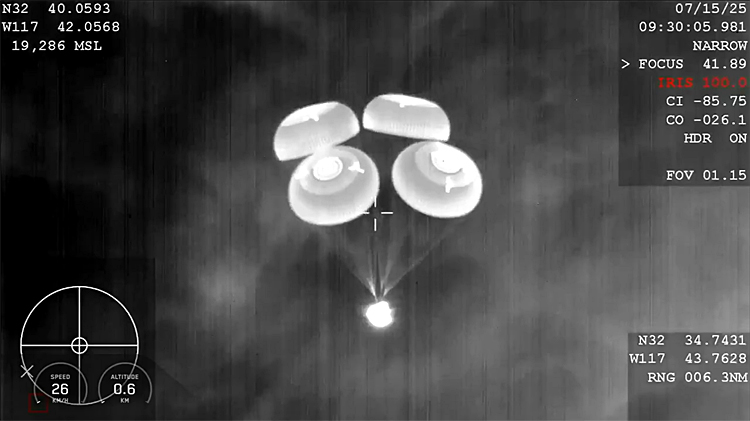INDIAN ARMED FORCES CHIEFS ON OUR RELENTLESS AND FOCUSED PUBLISHING EFFORTS

The insightful articles, inspiring narrations and analytical perspectives presented by the Editorial Team, establish an alluring connect with the reader. My compliments and best wishes to SP Guide Publications.

"Over the past 60 years, the growth of SP Guide Publications has mirrored the rising stature of Indian Navy. Its well-researched and informative magazines on Defence and Aerospace sector have served to shape an educated opinion of our military personnel, policy makers and the public alike. I wish SP's Publication team continued success, fair winds and following seas in all future endeavour!"

Since, its inception in 1964, SP Guide Publications has consistently demonstrated commitment to high-quality journalism in the aerospace and defence sectors, earning a well-deserved reputation as Asia's largest media house in this domain. I wish SP Guide Publications continued success in its pursuit of excellence.
- Prime Minister Modi Visits Punjab’s Adampur Air Base, Interacts with Airmen after Successful ‘Operation Sindoor’; Stern Message to Pakistan
- The layered Air Defence systems that worked superbly, the key element of Operation Sindoor
- Operation Sindoor | Day 2 DGMOs Briefing
- Operation Sindoor: India strikes back with Precision and Purpose
- Operation Sindoor: Resolute yet Restrained
- India’s Operation Sindoor Sends a Clear Message to Terror and the World – ‘ZERO TOLERANCE’
- Japan and India set forth a defence cooperation consultancy framework, talks on tank and jet engines
- Terrorist Attack in Pahalgam in Kashmir: Unfolding a long surgical war against PAK
- Lt General Pratik Sharma takes over Command of Indian Army's Northern Command
Axiom 4: Perfect Pacific Ocean Splashdown
India caps landmark space mission, ISRO to step up next — Gaganyaan & space station

July 15, 2025 marks the conclusion of Axiom Mission 4 with the safe splashdown of the Dragon "Grace" capsule carrying Group Captain Shubhanshu Shukla, Poland's Slawosz Uznanski, Hungary's Tibor Kapu, and NASA veteran Peggy Whitson in the Pacific Ocean off California.
For India, Shukla's return is far more than symbolic—it's the first time an astronaut has stepped aboard the ISS and returned in over four decades since Rakesh Sharma's historic flight in 1984.
"I join the nation in welcoming Group Captain Shubhanshu Shukla as he returns to Earth from his historic mission to Space. As India's first astronaut to have visited the International Space Station, he has inspired a billion dreams through his dedication, courage and pioneering spirit"
— Prime Minister Narendra Modi
Prime Minister Modi also lauded India's historic space milestone in his tweet: "I join the nation in welcoming Group Captain Shubhanshu Shukla as he returns to Earth from his historic mission to Space. As India's first astronaut to have visited the International Space Station, he has inspired a billion dreams through his dedication, courage and pioneering spirit. It marks another milestone towards our own Human Space Flight Mission - Gaganyaan."
His 18-day stay, during which he conducted seven ISRO experiments—including growing fenugreek and studying muscle regeneration—paves the way for the upcoming Gaganyaan mission in 2027.
For India, Shukla's return is far more than symbolic—it's the first time an astronaut has stepped aboard the ISS and returned in over four decades since Rakesh Sharma's historic flight in 1984
Shukla's successful mission strengthens India's standing in commercial spaceflight, fosters deeper international collaboration, and provides invaluable experience in astronaut training, microgravity operations, and human spaceflight readiness—crucial foundations as India charts its own path in crewed space exploration. Indian astronaut Group Captain Shubhanshu Shukla successfully piloted his Axiom Mission 4 (Ax-4) crew members back to Earth as they splashed down off the coast of San Diego at 3.01 p.m. IST. The crew had departed from the orbiting laboratory on July 14 onboard the SpaceX Dragon.


The Crew Dragon "Grace" capsule, carrying Group Captain Shubhanshu Shukla of the Indian Air Force and three international colleagues, undocked from the ISS at 4:35 p.m. IST on July 14 and commenced its return to Earth, with a scheduled splashdown off California's coast around 3 PM IST on July 15.
Scientific Triumphs & Research Breakthroughs
The Ax-4 research complement includes around 60 scientific studies and activities representing 31 countries, including the US, India, Poland, Hungary, Saudi Arabia, Brazil, Nigeria, UAE, and nations across Europe. According to the official mission team for Ax-4, this will be the most research and science-related activities conducted on an Axiom Space mission aboard the International Space Station to date, underscoring the mission's global significance and collaborative nature to advance microgravity research in low-Earth orbit (LEO).
His 18-day stay, during which he conducted seven ISRO experiments—including growing fenugreek and studying muscle regeneration—paves the way for the upcoming Gaganyaan mission in 2027
The mission scientists have elaborated that the mission emphasises scientific portfolios led by the US, India, Poland (in partnership with ESA), and Hungary. It aims to boost participation in these countries by involving diverse stakeholders, showcasing the value of microgravity research. The studies will focus on human research, Earth observation, life, biological, and material sciences, demonstrating the space research capabilities of the crew's home nations.
Shukla—fondly called "Shux"—conducted seven Indian-designed microgravity experiments, with four already completed and three nearing completion. Key highlights include:
Sprouts & Crop Seeds: Germination of moong, methi, and other crops in microgravity—vital for sustainable space farming.
Myogenesis: Studying muscle-cell regeneration to counter astronaut atrophy and support long-duration missions.
Microalgae & Cyanobacteria: Growth experiments investigating oxygen production, food supply, and bio-regeneration in closed-environment habitats.
Tardigrades: Resilience study of water bears in extreme conditions, with potential applications in radiation protection.
Voyager Displays: Human–machine interface testing that evaluates verbal and cognitive performance in zero-G.
Health & Metabolism: Research on bone health, radiation effects, and even glucose metabolism (diabetes study) under microgravity.
These experiments not only provide immediate insights for life sciences but also lay the groundwork for Gaganyaan, India's first indigenous crewed mission, by validating critical systems for human health, nutrition, and habitability in space
These experiments not only provide immediate insights for life sciences but also lay the groundwork for Gaganyaan, India's first indigenous crewed mission, by validating critical systems for human health, nutrition, and habitability in space.
What It Means for Gaganyaan
The success of Axiom 4 offers a treasure trove of learnings for Gaganyaan, slated for 2027–28. ISRO has announced plans to launch Gaganyaan - the country's first-ever human space flight in 2027 - and has ambitious plans to set up a space station by 2035 and send an astronaut to the Moon by 2040. Group Captain Shukla is among four Indian air force officers shortlisted last year to travel on Gaganyaan. Through hands-on experience in uncrewed coordination, health monitoring, experiment handling, crew-ground communications, and spacecraft docking, Shukla has effectively tested and reported back systems that are cornerstones of a sustained Indian human spaceflight programme.
ISRO's own statement underlines this outcome: experiments on microgravity biology, plant science, human physiology, and interface design will directly support Gaganyaan and the upcoming Bharatiya Antariksha Station.
What's Next? India's Spaceflight Roadmap
The immediate step, as is the norm in most of the successful space journeys, is for the astronaut, including Shubhanshu Shukla's rehabilitation and data analysis.
After splashdown, Shukla will undergo a week-long medical and physiological rehabilitation overseen by ISRO and NASA partners. Scientific samples will be returned to India for detailed laboratory analysis, particularly from completed experiments like Myogenesis and Microalgae.
By safely returning Shubhanshu Shukla and scientific findings from microgravity, Axiom 4 has established a clear path for India's progress towards independent space travel
The next phase would be dedicated to Gaganyaan Crew Preparation. Insights from Grace's crew-ground dynamics and experiment outcomes will refine astronaut selection, training protocols, spacecraft interfaces, sensor systems, and biomedical preparedness for Gaganyaan.
Launch of Gaganyaan Mission
India is targeting a crewed launch between 2027 and 2028, utilising the Gaganyaan spacecraft and LVM3 rocket to send three Indian astronauts into low Earth orbit. Axiom 4's findings will be pivotal to ensuring mission safety, crew health, and operational readiness.
By safely returning Shubhanshu Shukla and scientific findings from microgravity, Axiom 4 has established a clear path for India's progress towards independent space travel. As scientific samples and data come back home, India's Gaganyaan mission is ready to launch—with increased confidence, validated systems, and a new generation of astronauts prepared to follow.
Manish Kumar Jha is a Consulting & Contributing Editor for SP's Aviation, SP's Land Forces and SP's Naval Forces and a security expert. He writes on national security, military technology, strategic affairs & policies.





